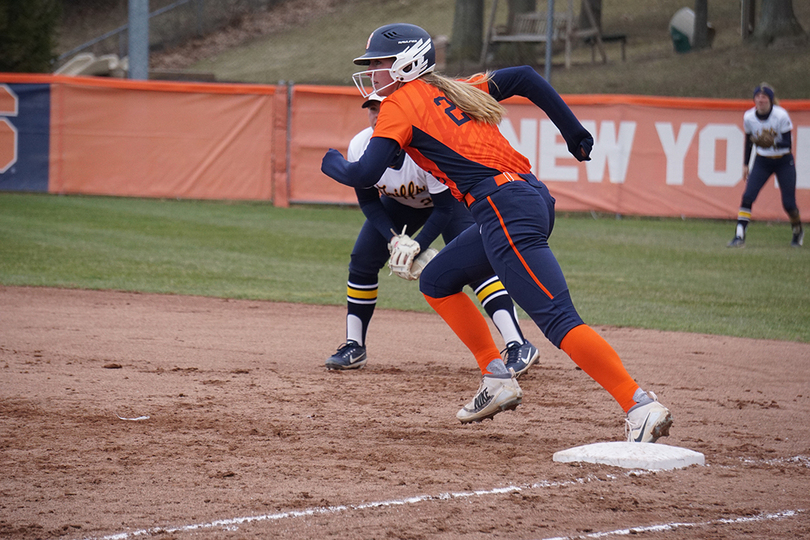Syracuse saves runs by rotating its outfielders

Toni Martin and the rest of Syracuse outfielders often move positions in between hitters. Jordan Phelps | Staff Photographer
In Syracuse’s first 28 games of the season, mid-inning position changes were almost nonexistent.
Unless a player had to leave due to injury or a pinch-runner or hitter was inserted into the game, players who started the game stayed in their position for all seven innings. But in four of the Orange’s last five series, head coach Mike Bosch has employed temporary in-game position changes.
When a left-handed batter with a tendency to hit to the opposite field steps to the plate against SU, the three outfielders — Bryce Holmgren, Alicia Hansen and Toni Martin — swap positions. Hansen moves from center to left field, while Martin moves from right to center and Holmgren from left to right.
“Alicia is faster than Bryce. That’s pretty much it,” Bosch said on the reasoning for the switches. “If there’s a ball that we can run down that gives us any advantage, we’re going to do it.”
The defensive tactic has helped Syracuse (21-18, 5-11 Atlantic Coast) give itself the best possible chance to win. To keep a runner from advancing an extra base or scoring is even more important for SU, which has scored two runs or fewer in 17 games this year and played in 11 games decided by one run.
Syracuse first switched its outfield against Boston College on March 31, when BC’s Lexi DiEmmanuele came to the plate in the top of the second inning. As the lefty hitter walked from the on-deck circle, Holmgren, Hansen and Martin repositioned themselves. They jogged to their temporary spots in right, left and center, respectively. After DiEmmanuele struck out, each outfielder returned to their original position.
The outfielders know exactly which batters to switch for without signals from Bosch, as the Orange memorize the switching points in an opponent’s batting order.
“In practice, (the coaching staff) will tell us where they want us to play based on which batter it is,” Hansen said. “So come game time, it’s muscle memory.”
In addition to applying the swap for DiEmmanuele and later Olivia Markopoulos when it played BC, SU has switched for Canisius’ Erin Hufford and Kara Paradowski, Notre Dame’s Ali Wester and Louisville’s Maddy Newman. All six players are left-handed batters who the coaches identify as opposite-field hitters when analyzing film.
Bosch and the outfielders are willing to make the shift because Holmgren, Hansen and Martin are comfortable in each of the three outfield positions. College-level outfielders should be able to play each outfield spot with ease, Hansen said.
“All the outfield positions are the same, they’re just at different angles,” Hansen said. “Changing positions in the outfield is just a matter of where you’re seeing the ball off the bat.”
Since Bosch implemented the swap, seven balls have reached the outfield while the players were in their alternate positions. Of the seven, four went directly to Hansen in left field, just like Bosch predicted. Two went to the left-center gap and one to Martin in center field. Louisville’s Newman did the most damage by sending the ball to the gap in left-center, but Hansen tracked it down before Newman advanced past second base.
While this kind of shift is rare in softball, Bosch said, it is important for Syracuse to do everything it can to limit runs. Although Holmgren has one less error than Hansen this season, Hansen’s ability to get to a ball down the line or in the gap quicker than Holmgren is Bosch’s main reasoning for implementing the switch.
With the number of close games SU has played in and its scoring struggles, the outfield swap is a small but critical adjustment.
“We’re all comfortable with it and it’s a good thing to be aware of,” Martin said. “We’ll keep doing it as long as it helps us save runs.”




